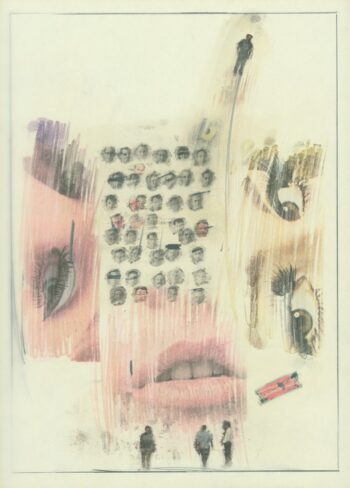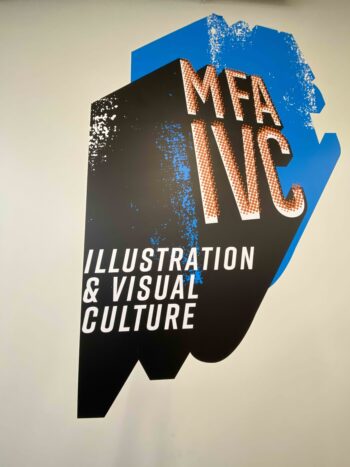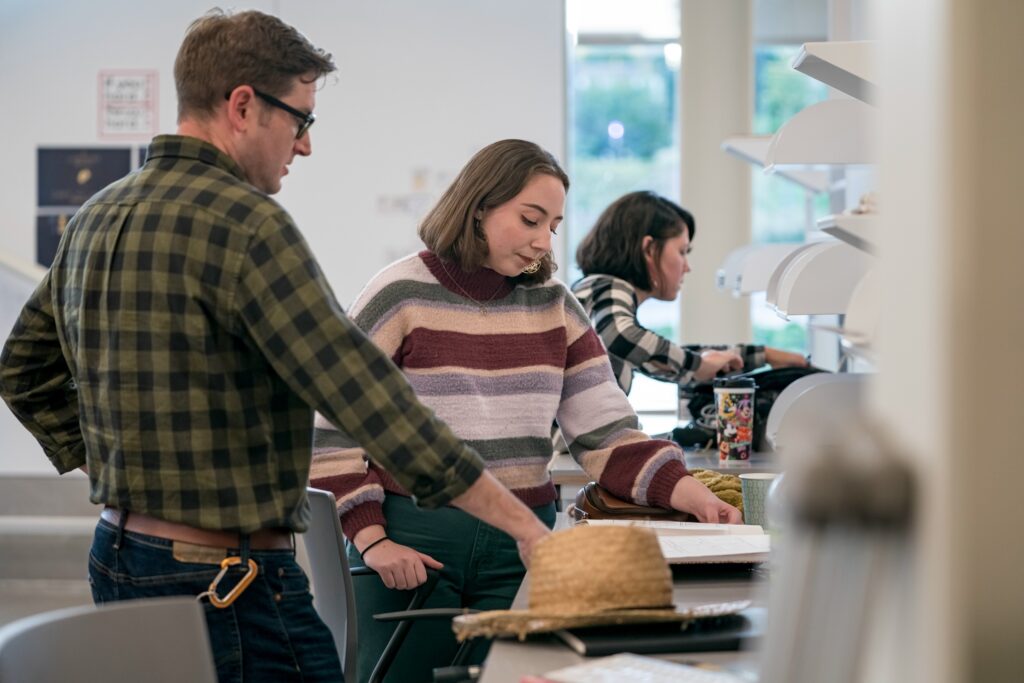
University Libraries Partner with Sam Fox School on New MFA Program
Washington University’s new MFA in Illustration & Visual Culture program (MFA-IVC) is giving art students the opportunity to grow as scholars outside the studio. Launched in fall 2019, the two-year program is a collaboration between the Sam Fox School of Design & Visual Arts and the Washington University Libraries.
The MFA-IVC is offered through the Sam Fox School. Along with Sam Fox faculty, staff from the University Libraries teach in the program, and the archival illustration collections housed in the D.B. Dowd Modern Graphic History Library (DMGHL), a division of the University Libraries’ Julian Edison Department of Special Collections, are central to the degree curriculum.
The program was designed, in part, to familiarize incoming artists with the academic world—to equip them with research skills, sharpen their analytical abilities, and get them thinking and writing in the manner of the scholar or the critic. Students in the program log studio hours making art, but they also explore theories of visual culture and illustration history and learn curatorial practices. It’s an uncommon course of study that sets the MFA-IVC apart from other graduate fine-arts programs.
An archival advantage
John Hendrix, associate professor in the Sam Fox School, teaches in the MFA-IVC and serves as its chair. He feels that the program has no real equal in terms of what it offers.
“This exposure to what a library can do and what being inside an archive can mean to your own creative practice is incredibly valuable,” he says. “These are things the students need to experience firsthand. Being able to collaborate with the University Libraries in this way was one of the reasons we wanted to build this program. The Libraries are an incredible asset.”
An inaugural group of 12 students—illustrators all—was admitted to the program in fall 2019, and the world of academics and archives is new territory to many of them. Their backgrounds include animation, painting, comics, and children’s books. Some of them have been working professionally for years, and some are fresh out of college.
DMGHL Curator Skye Lacerte has been working with the students in the archives and enjoys the unique perspectives they have to offer. “They’re illustrators, and so they see things differently than I do,” she says. “I tend to focus on content, while they might notice pencil markings on a piece or subtle elements related to technique. I love exposing them to items from the past and seeing what they get out of it.”
With Joy Novak, head of Special Collections Management at the University Libraries, Lacerte teaches two required courses in the MFA-IVC: Special Collections: Practice & Purpose and a modern graphic history practicum. The materials in the DMGHL are key to their teaching.
Based at Washington University’s West Campus Library, the DMGHL is a world-class center for the study of 20th-century American illustration. It was established in 2007 by Douglas Dowd, professor of art and American culture studies at Washington University, who serves as its faculty director. The DMGHL houses one of the most comprehensive collections of the work of artist Al Parker (1906-1985), a Washington University alumnus and one of America’s most innovative and influential illustrators.
Other DMGHL highlights include the Walt Reed Illustration Archive—a trove of illustrated books, original works of art, and thousands of periodicals and magazine tearsheets. The collection features examples of work by major illustrators, with an emphasis on the late 19th and early 20th centuries.
In their courses, Lacerte and Novak assign research and writing projects related to the collections. The ability to provide students with access to the DMGHL makes the program special, Lacerte believes. Exposing them to rare materials related to the history of their chosen medium provides them with valuable context. It also opens up curation as a possible career path.
Nadia Ghasedi, associate university librarian for Special Collections Services at the University Libraries, agrees that the program is unique. “It gives students the opportunity to truly embed in special collections and archives,” Ghasedi says. “This is the only program at the university that so formally integrates the University Libraries. It’s a trailblazing program, and we’re thrilled to be partnering on it with the Sam Fox School.”
Evangelizing for visual culture
The MFA-IVC program is based in Anabeth and John Weil Hall, which opened in fall 2019 as part of Washington University’s East End Transformation—a construction project that brought new academic buildings and other improvements to the eastern portion of the Danforth Campus. Weil Hall houses the Sam Fox School’s graduate programs in architecture, art, and design. The 82,000-square-foot, glass-fronted facility is equipped with cutting-edge art and design resources.
The MFA-IVC students work in the Roxanne H. Frank Design Studio, a collaborative space in Weil Hall with computer stations, areas for viewing and critiquing work, and a print hub. Approximately half of the MFA-IVC’s curriculum is made up of time in the studio; the rest stresses history and theory. There’s a survey course in comics, cartooning, and animated film, and a class in the history of the periodical. A number of Sam Fox School faculty members—Douglas Dowd, Shreyas R. Krishnan, Heidi Kolk, and Jeff Pike among them—teach in the program.
“We’re covering areas inside the field of illustration that haven’t been taken seriously,” Hendrix says. “We are evangelizing for visual culture study. Illustration has often been seen as a kind of dumb field. Like you wait for the client to call you, and then you do what they want. That’s a very crude understanding of what illustration is. There’s so much more to it.”
Correcting this misconception is part of the program’s mission—a goal it shares with the DMGHL. Both aim to bring attention to American illustration and the study of visual culture as under-explored areas of inquiry. Because illustrators are shapers of visual culture, Hendrix says, their work warrants scholarly consideration.
The students in the program are immersed in the theory and background of the medium, which they’re learning to evaluate as a cultural force. Through the collections in the DMGHL, they’re able to see the breadth and scope of the form firsthand and get a sense of how—over the decades—it has impacted everything from advertising and animation to literature, film, and design.
“Many of the students see through a studio-art lens, an art-making lens. Of course they’re going to be used to that approach,” Hendrix says. “But we’re getting them into the library to learn about the collections and history and curation. We’re building a cohort that we hope will go out and continue this work.”
Creators as curators
During the spring 2020 semester, in their modern graphic history course, Novak and Lacerte focused on exhibitions and outreach. The class planned a big final project—an exhibit of DMGHL materials that would open in the summer, in John M. Olin Library. The exhibit would highlight the materials they’d been focusing on, including the Al Parker Collection and the Walt Reed Illustration Archive.
For the project, the students split up into small groups, each of which would have its own case in the exhibit. In addition to curating items for the show, they’d design accompanying elements like wall text, labels, and promotional posters. During a class held in the Department of Special Collections, the students discussed possible concepts for their cases. Their ideas were a testament to the breadth of the materials in the DMGHL and to what those materials might reveal.

One team suggested showcasing the progression of a single illustration, from preliminary sketches all the way through to the piece’s final, archived form—as a tearsheet in the DMGHL. Another group proposed putting together a display of correspondence, business and otherwise, connected to an illustration by Al Parker—everything from fan letters and contracts, to paperwork related to models, art directors, and photographers. The idea was to highlight the workforce—the team that operated behind the scenes to help bring an illustration into being.
The exhibit was the sort of hands-on undertaking that could only happen through direct access to archives.
“We’re able to give students a good idea of what we do as curators and to show them how to handle historical records and objects,” Lacerte says. “And I think we’re filling a need to prepare people to do that sort of work. The scholarship of illustration is a developing field. There are illustrators, of course, but there aren’t many who are also critics and curators and historians and teachers. Through the program, we’re hoping to change that.”
The MFA-IVC is already growing. Hendrix has been considering a new batch of applications and is preparing to admit next year’s class. In the coming months, he’ll start working with the current crop of students on their final thesis projects, and he’s excited about what they might come up with.
“Some of them may do 100% visual work, like a graphic novel, but I think some of the students will combine making work with writing about it in a critical way,” he says. “Some of them are now hooked on research, and I can’t wait to see what they come up with.”


